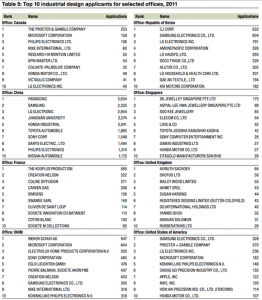 Computer technology accounted for more patent applications in recent years than any other industry sector tracked by the World Intellectual Property Organization, although the number of digital communication patent applications grew faster. Industrial design registrations are also growing — and while Apple aggressively asserts its design rights in courtrooms, it does not file the most applications for such rights.
Computer technology accounted for more patent applications in recent years than any other industry sector tracked by the World Intellectual Property Organization, although the number of digital communication patent applications grew faster. Industrial design registrations are also growing — and while Apple aggressively asserts its design rights in courtrooms, it does not file the most applications for such rights.
The number of patent applications worldwide topped 2 million for the first time in 2011, WIPO said in a report on worldwide intellectual property registrations, released Tuesday. It noted that applications to register industrial design rights also rose sharply that year.
WIPO gathered application data from patent and trademark offices around the world, breaking it down by industry sector and country. One source, the European Patent Office’s PATSTAT database, had not broken down 2011 data by sector at the time of its last update in April, so WIPO’s per-industry analysis ends in 2010.
Filings for computer technology patents rose by 1.9 percent a year between 2006 to 2010, reaching a peak of 129,952 in 2009 before falling back to 126,897 in 2010, according to the WIPO report.
Patent filings on digital communication technologies grew faster, though, at 8.1 percent, rising to 71,499 applications in 2010.
Besides patent applications, the WIPO also looked at industrial design rights applications by technology firms. Design rights are closely linked to patents and were the subject of numerous disputes in 2012, WIPO said.
“Frequently, these disputes focus on the infringement of patents and the underlying technological inventions. Yet some of the highest profile conflicts relating to smartphones and tablet computers have centred on product designs,” the organisation said. Courts worldwide are making decisive judgments on which designs can be protected and what constitutes infringement of a design right, it added.
Ericsson, for example, recently announced it was suing Samsung for patent infringement, asking a U.S. judge to block sales of Samsung Electronics products such as the Galaxy S III smartphone and the Galaxy Note II in the U.S. And earlier this year Samsung was ordered by a jury to pay over $1 billion to Apple for patent infringement.
Samsung has also been fighting in the courts with Apple, which says Samsung copied its iPad tablet design.
Companies such as Samsung, LG, Research in Motion, Panasonic, Sony, Microsoft and Foxconn consistently emerged as the top users of design patents in the electronics, ICT and software industries in 2011, the WIPO said.
Apple, though, wasn’t the biggest user of industrial design rights in 2011, WIPO data reveals. It ranked sixth for industrial design registrations in the U.S. in 2011, with 122 registrations, behind Samsung (328), LG (236) and Microsoft (182). For seven other major registries, WIPO counted industrial design applications, not registrations, and in those countries Apple did not make the top 10 at all.
In China, Japan and the Republic of Korea, firms in the electronics and ICT industries ranked among the most intensive users of industrial design rights, according to WIPO. “In the case of China, for the most part foreign firms occupied the top 10 ranks. Interestingly, the only entity of Chinese origin in these rankings is a university,” it added.
Most design right applications were filed in China, where Panasonic ranked first with 3,634 design right applications filed, followed by Samsung with 3,335 and LG with 2,844 applications.
Design rights today are a substantial share of firms’ investments in intangible assets and innovation. However, further research is needed to reveal how the legal and creative aspects of industrial design activity relate to one another, WIPO said.





